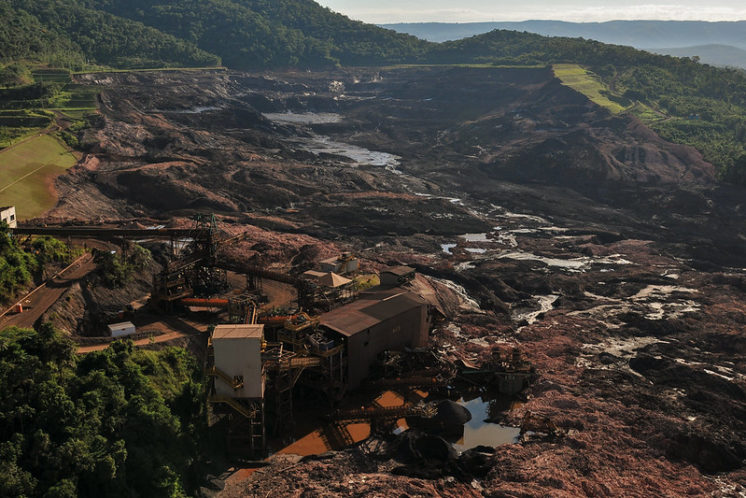Following the burst of the B1 dam near Brumadinho in Brazil in 2019, which killed more than 270 people, evidence suggests that the dam’s owner Vale sought certification of the dam by Tüv Süd while knowing about the severe safety risks. At the time of writing (June 2020), Vale, Tüv Süd and several of their employees are being prosecuted.
 Photo: Ibama / Flickr
Photo: Ibama / FlickrOn 25 January 2019, the B1 dam near Brumadinho in Brazil broke, killing more than 270 people, contaminating the drinking water of thousands, and seriously damaging the environment.[1] Vale S.A., the company that operates the dam, declared that the dam’s safety factor was in accordance with worldwide best practices and that regular inspections had reported that the dam was meeting all necessary safety standards.[2]
The failure of the dam originated from a process called liquefaction, in which solid materials under the water turn into a murky liquid due to high water pressure.[3] Problems linked to liquefaction were known to workers of the Bureau de Projetos e Consultoria (the Bureau), the Brazilian subsidiary of the German certification company Tüv Süd, which had carried out inspections of the dam.
The Bureau had identified problems with the dam’s drainage already in March 2018, but had gone on to issue safety certification for the dam in the following months.[4] In order to do so, the Bureau issued a certification for the dam that was tied to certain recommendations provided in an accompanying report. This included refraining from using heavy equipment at the dam, which is an unlikely situation in a mining region, and avoiding blastings in the area.[5] Furthermore, the norm to declare the dam as safe was set to a lower standard than usual and common for these types of dam safety assessments.[6]
It is unclear what led the Tüv Süd subsidiary to take this action. Experts point to the fact that Vale had dismissed two companies that had previously refused to issue certifications due to safety concerns for the dam and underline the fact that the contract it had with the certifier was worth approximately €4 million.[7] Indeed, these experts point out that the situation in that companies such as Vale pay for the services of certification bodies “inevitably leads to a conflict of interest”.[8]
There is strong evidence that suggests Vale was aware of the risks and instabilities linked to the B1 dam as early as 2003.[9] Internal documents from the company dating from October 2018 reportedly classified the dam as twice as likely to fail than the maximum tolerated risk level under internal guidelines.[10]
Furthermore, it is important to note that this particular type of “upstream” dam is known for being particularly vulnerable to failures (it is banned in Canada and Chile), but it is cheaper than its alternatives.[11] Indeed, following the Brumadinho collapse, Brazil’s National Mining Agency has ordered the decommissioning of all upstream dams in Brazil, considering the risk they represent for populations and the environment.[12]
Additionally, errors from previous incidents such as the Rio Doce disaster seem to have been repeated in Brumadinho. This is a pattern the prosecutor recognises, claiming to have robust proof of Vale’s former CEO Flavio Schvartsman’s knowledge of unacceptable security conditions in several of the company’s dams, including B1 in Brumadinho.[13]
However, Vale has rejected responsibility for the dam’s failure, pointing to their reliance on the certification issued by the Tüv Süd Bureau.[14] In its review of an earlier draft of this case study, the company insists that it was impossible to predict the dam’s failure, that the failure was sudden and abrupt, that the dam’s safety had been verified by independent experts, and that the technical causes of the dam failure are still not conclusively settled.[15] In its review comment[16], Tüv Süd points out that, under Brazilian liability law, the responsibility for safety remains with the dam owner. It highlights the conditions tied to their certification and the existence of witness statements that have reported breaching of one of these conditions. Like Vale Tüv Süd stresses that that the cause of the dam break has not yet been concluded. Both companies share their deep regret for the victims and their families, and Vale brings to the attention their repair programme[17] (which in fact has received quite a lot of criticism from stakeholders).[18]
In January 2020, Brazilian prosecutors announced that they had filed charges against 11 of Vale’s employees including Schvartsman, and five of the certifier’s employees. These charges included both homicide and environmental damage.[19] Furthermore, the companies themselves, both Vale and Tüv Süd, have been charged with environmental crimes in connection with the Brumadinho case too.[20] Vale strongly rejects the suggestion of a criminal intent in their dealings with the safety of the dam. The criminal proceedings are at their early stages, and there are no convictions at the time of writing (June 2020).
[1] European Centre for Constitutional and Human Rights and others, “Deadly dam breach near Brumadinho: Affected persons file complaint against TÜV SÜD in Germany,” October 17, 2019, https://176903.seu2.cleverreach.com/m/11609620/0-ce990cb4ad2272226888c5d09340963d (accessed December 9, 2019).
[2] Shasta Darlington and others, “A Tidal Wave of Mud,” The New York Times, February 9, 2019, https://www.nytimes.com/interactive/2019/02/09/world/americas/brazil-dam-collapse.html (accessed December 9, 2019).
[3] Tom Wills, “German firm sets aside millions for Brazil dam disaster costs,” Deutsche Welle, August 20, 2019, https://www.dw.com/en/german-firm-sets-aside-millions-for-brazil-dam-disaster-costs/a-50101067 (accessed December 9, 2019).
[4] European Centre for Constitutional and Human Rights and others.
[5] Shasta Darlington and others, “A Tidal Wave of Mud,” The New York Times, February 9, 2019, https://www.nytimes.com/interactive/2019/02/09/world/americas/brazil-dam-collapse.html (accessed December 9, 2019); Tüv Süd. “Email: Review Comments,” April 27, 2020.
[6] Extraordinary Independent Consulting Committee for Investigation. “Executive Summary of the Independent Investigation Report,” p. 22, February 20, 2020. http://www.vale.com/PT/investors/Documents/20.02.20_CIAEA_Report_i.pdf.(accessed June 8, 2020)
[7] Jenny Hill, “Brazil dam: How German firms approved Brazil dam before tragedy,” BBC News, July 18, 2019, https://www.bbc.com/news/world-europe-48948775 (accessed December 9, 2019).
[8] European Centre for Constitutional and Human Rights and others.
[9] Gram Slattery and Martha Nogueira, “Brazil’s Vale dam disaster report highlights governance shortcomings”, Reuters, February 21, 2020 https://uk.reuters.com/article/uk-vale-disaster/brazils-vale-dam-disaster-report-highlights-governance-shortcomings-idUKKBN20F2SM?feedType=RSS&feedName=worldNews (accessed March 9, 2020); Extraordinary Independent Consulting Committee for Investigation
[10] BBC, “Vale ‘knew collapsed dam was at risk’, says report”, Feburary 2019, https://www.bbc.com/news/business-47209265 (accessed March 16, 2020); Terrence McCoy, “Brazilian police file criminal charges in dam collapse that killed more than 200,” The Washington Post, September 20, 2019, https://www.washingtonpost.com/world/the_americas/brazilian-police-file-first-criminal-charges-over-deadly-dam-collapse/2019/09/20/fa6bf7f0-dbb2-11e9-a1a5-162b8a9c9ca2_story.html (accessed December 9, 2019); Stephen Eisenhammer, “Exclusive: Brazil miner Vale knew deadly dam had heightened risk of collapse,” Reuters, February 11, 2019, https://www.reuters.com/article/us-vale-sa-disaster-exclusive-idUSKCN1Q0287 (accessed December 9, 2019).
[11] De Sá, Gabriel. “Brazil’s Deadly Dam Disaster May Have Been Preventable.” National Geographic, January 29, 2019. Stephen Eisenhammer, “Exclusive: Brazil miner Vale knew deadly dam had heightened risk of collapse,” Reuters, February 11, 2019, https://www.reuters.com/article/us-vale-sa-disaster-exclusive-idUSKCN1Q0287 (accessed December 9, 2019).
[12] Watson, R.T. “Brazil Bans Upstream Mining Dams After Vale’s Latest Disaster.” Bloomberg News, February 18, 2019. https://www.bloomberg.com/news/articles/2019-02-18/brazil-bans-upstream-mining-dams-after-vale-s-latest-disaster.
[13] Marcelo De Sousa, “Brazil prosecutors charge Vale, individuals in dam disaster”, January 23, 2020 (accessed on March 9, 2020)
[14] European Centre for Constitutional and Human Rights and others.
[15] Vale S.A.“RE: Review announcement case description Vale”. 21 April 2020
[16] Tüv Süd Brazil. “RE: Review announcement case description Tuv”. 27 April 2020
[17] Vale. “Repair and Development: Repair Overview.” (accessed June 8, 2020); International Federation for Human Rights, “Brumadinho Dam: NGOs Urge Companies and Investors to Use Leverage and Require Vale to Remedy the Situation.” Brumadinho dam: NGOs urge companies and investors to use leverage and require Vale to remedy the situation, February 21, 2019. (accessed June 8, 2020)
[19] Marcelo De Sousa, “Brazil prosecutors charge Vale, individuals in dam disaster,” CTV News, January 22, 2020, https://www.ctvnews.ca/business/brazil-prosecutors-charge-vale-individuals-in-dam-disaster-1.4778061 (accessed January 23, 2020).
[20] CBC News, “MiningWatch Canada pushes for global review of safety of tailings dams”, CBC News, January 23, 2020, https://www.cbc.ca/news/canada/sudbury/vale-brazil-dam-collapse-miningwatch-review-tailings-dams-safety-1.5437591 (accessed March 9, 2020)
